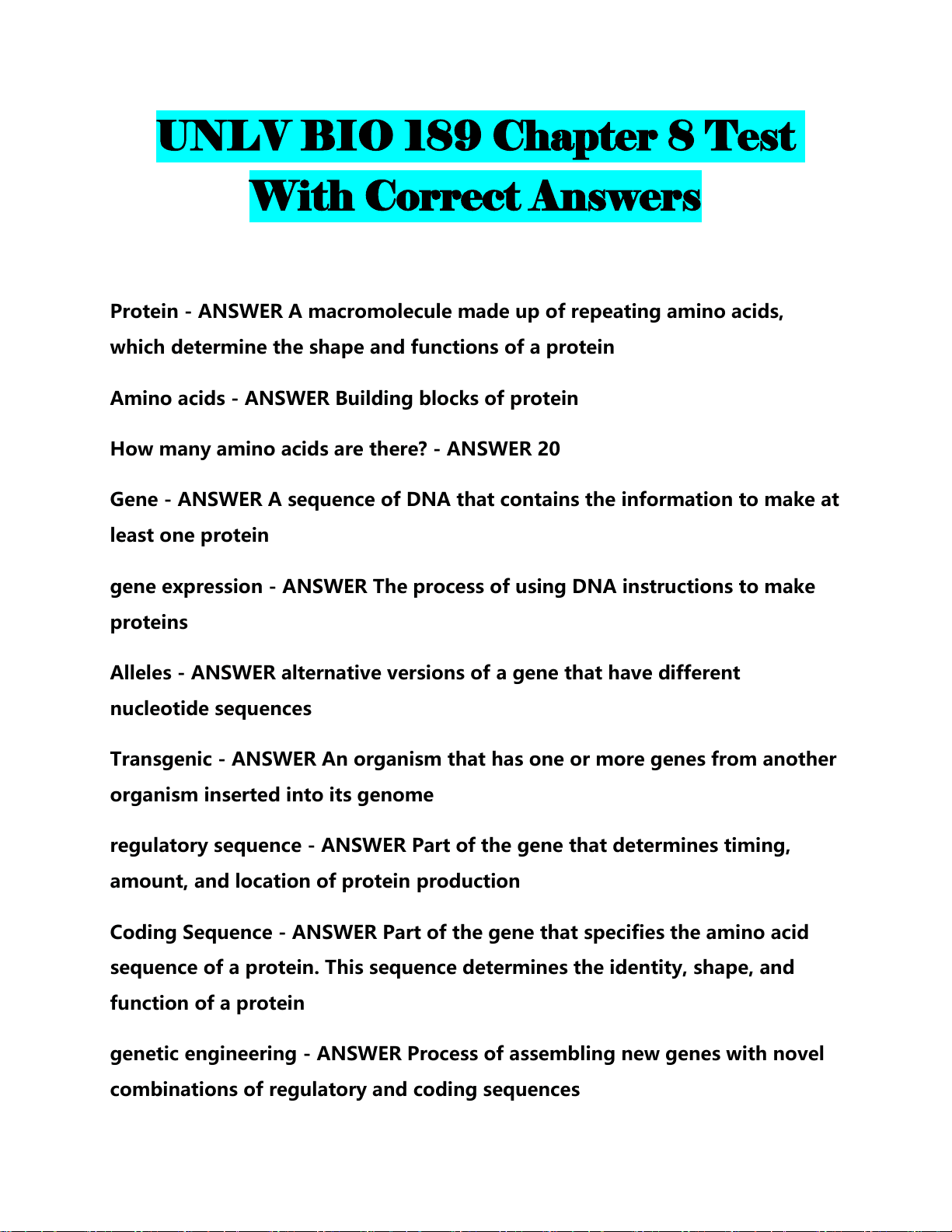
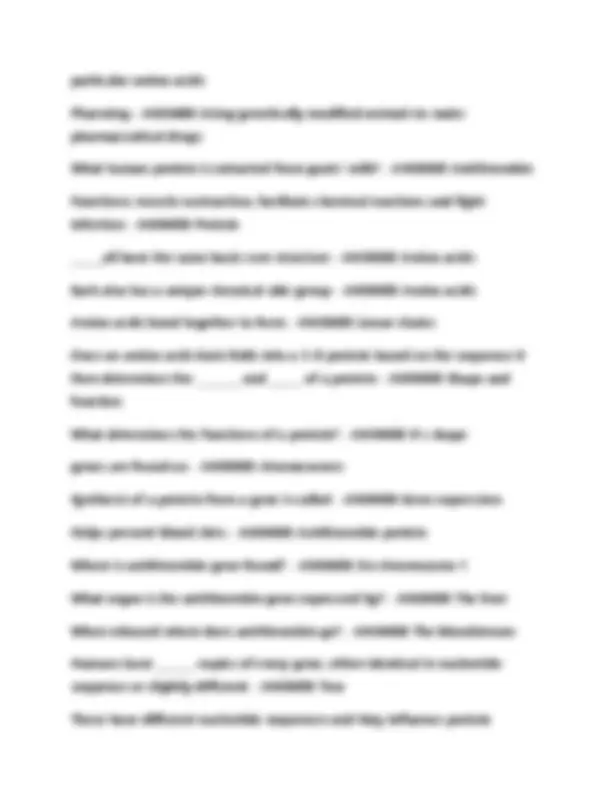
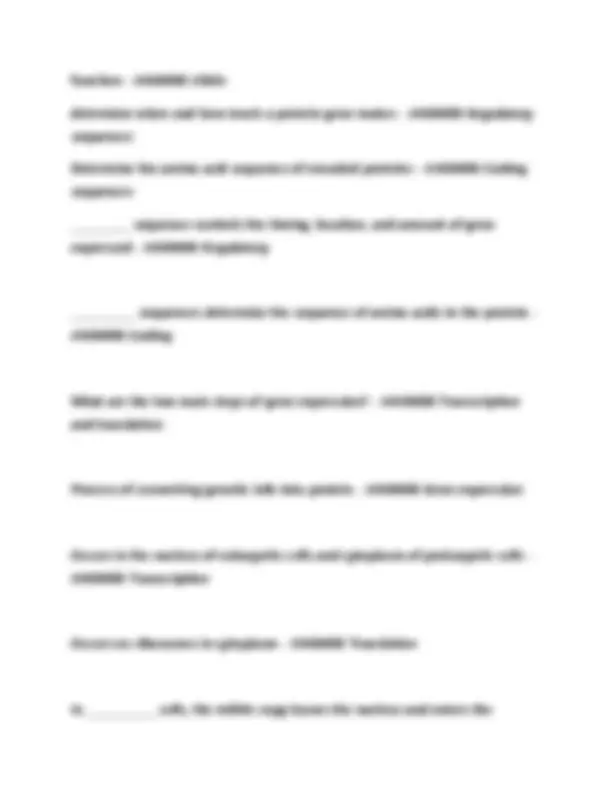
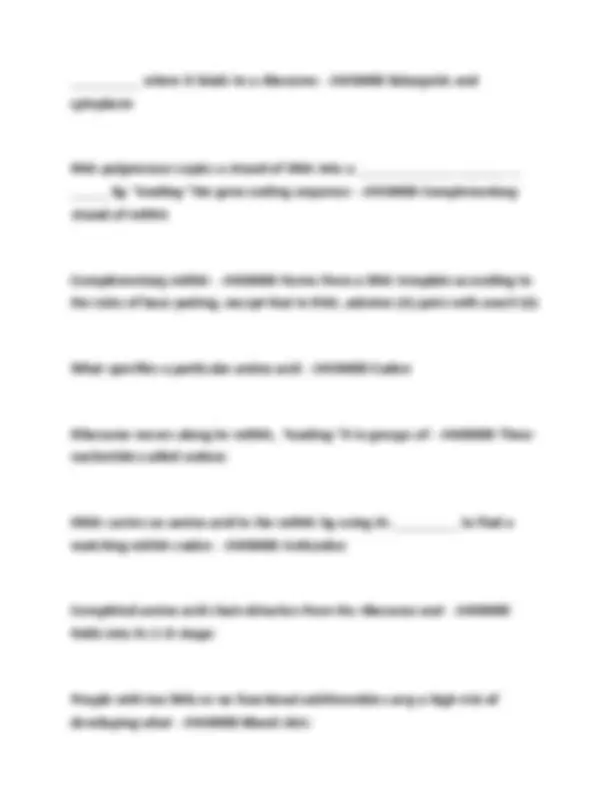
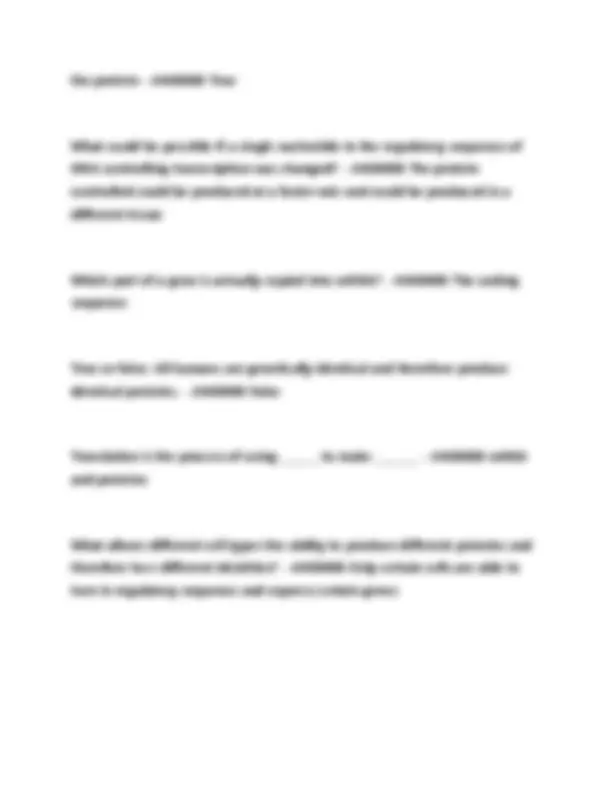


Study with the several resources on Docsity

Earn points by helping other students or get them with a premium plan


Prepare for your exams
Study with the several resources on Docsity

Earn points to download
Earn points by helping other students or get them with a premium plan
Community
Ask the community for help and clear up your study doubts
Discover the best universities in your country according to Docsity users
Free resources
Download our free guides on studying techniques, anxiety management strategies, and thesis advice from Docsity tutors
A comprehensive overview of genetics, focusing on genes, proteins, and the process of gene expression. it explores key concepts such as transcription, translation, and the roles of mrna, trna, and ribosomes. the document also includes numerous questions and answers to test understanding and reinforce learning, making it a valuable resource for students studying genetics at the university or high school level. specific examples, such as the antithrombin gene and its expression in goats' milk, are used to illustrate key concepts.
Typology: Exams
1 / 8

This page cannot be seen from the preview
Don't miss anything!





Protein - ANSWER A macromolecule made up of repeating amino acids, which determine the shape and functions of a protein
Amino acids - ANSWER Building blocks of protein
How many amino acids are there? - ANSWER 20
Gene - ANSWER A sequence of DNA that contains the information to make at least one protein
gene expression - ANSWER The process of using DNA instructions to make proteins
Alleles - ANSWER alternative versions of a gene that have different nucleotide sequences
Transgenic - ANSWER An organism that has one or more genes from another organism inserted into its genome
regulatory sequence - ANSWER Part of the gene that determines timing, amount, and location of protein production
Coding Sequence - ANSWER Part of the gene that specifies the amino acid sequence of a protein. This sequence determines the identity, shape, and function of a protein
genetic engineering - ANSWER Process of assembling new genes with novel combinations of regulatory and coding sequences
Recombinant gene - ANSWER A genetically engineered gene
Genetically Modified Organism (GMO) - ANSWER An organism that hat has been genetically altered by humans
Gene therapy - ANSWER the process of changing a gene to treat a medical disease or disorder
Transcription - ANSWER The first stage of gene expression, during which cells produce molecules of messenger RNA (mRNA) from the instructions encoded within genes in DNA
Messenger RNA (mRNA) - ANSWER The RNA copy of an original DNA sequence made during transcription
Translation - ANSWER Second stage of gene expression, during which mRNA sequences are used to assemble the corresponding amino acids to make a protein
RNA polymerase - ANSWER Enzyme that carries out transcription. Copies a strand of DNA into complementary strand of mRNA
Ribosome - ANSWER The cellular machinery that assembles proteins during translation
Codon - ANSWER A sequence of three mRNA nucleotides that specifies a particular amino acid
Transfer RNA (tRNA) - ANSWER Type of RNA that transports amino acids to the ribosome during translation
Anticodon - ANSWER the part of a tRNA molecule that binds to a complementary mRNA codon
Genetic code - ANSWER the set of rules relating particular mRNA codons to
function - ANSWER Allele
determine when and how much a protein gene makes - ANSWER Regulatory sequences
Determine the amino acid sequence of encoded proteins - ANSWER Coding sequences
___________ sequence controls the timing, location, and amount of gene expressed - ANSWER Regulatory
____________ sequences determine the sequence of amino acids in the protein - ANSWER Coding
What are the two main steps of gene expression? - ANSWER Transcription and translation
Process of converting genetic info into protein - ANSWER Gene expression
Occurs in the nucleus of eukaryotic cells and cytoplasm of prokaryotic cells - ANSWER Transcription
Occurs on ribosomes in cytoplasm - ANSWER Translation
In _____________ cells, the mRNA copy leaves the nucleus and enters the
_____________ where it binds to a ribosome - ANSWER Eukaryotic and cytoplasm
RNA polymerase copies a strand of DNA into a __________________ _________ __ _______ by "reading" the gene coding sequence - ANSWER Complementary strand of mRNA
Complementary mRNA - ANSWER Forms from a DNA template according to the rules of base pairing, except that in RNA, adenine (A) pairs with uracil (U)
What specifies a particular amino acid - ANSWER Codon
Ribosome moves along he mRNA, "reading" it in groups of - ANSWER Three nucleotides called codons
tRNA carries an amino acid to the mRNA by using its ____________ to find a matching mRNA codon - ANSWER Anticodon
Completed amino acid chain detaches from the ribosome and - ANSWER Folds into its 3-D shape
People with too little or no functional antithrombin carry a high risk of developing what - ANSWER Blood clots
Is the antithrombin gene construct present in every cell or only mammary cells? Why? - ANSWER In every cell because it was introduced in the embryo
Is the antithrombin gene construct expressed in every cell or only mammary cells? Why? - ANSWER Only in mammary cells because its regulatory region is specific for expression in mammary cells
Producing a single transgenic founder animal requires implanting approximately ________________ embryos that contain the recombinant gene - ANSWER 100-
True or false: when antithrombin genes are expressed they produce antithrombin protein. - ANSWER True
Why are many drugs either proteins or drugs that interact with proteins? - ANSWER Proteins play a vital role within cells which allow cells to function
True or false: there is a greater risk of transmitting infections such as hepatitis when genetically modified animals are used to produce protein instead of using proteins from human donors - ANSWER False
True or false. Changing one amino acid may or may not change the shape of
the protein - ANSWER True
What could be possible if a single nucleotide in the regulatory sequence of DNA controlling transcription was changed? - ANSWER The protein controlled could be produced at a faster rate and could be produced in a different tissue
Which part of a gene is actually copied into mRNA? - ANSWER The coding sequence
True or false. All humans are genetically identical and therefore produce identical proteins. - ANSWER False
Translation is the process of using _______ to make ________ - ANSWER mRNA and proteins
What allows different cell types the ability to produce different proteins and therefore ha e different identities? - ANSWER Only certain cells are able to turn in regulatory sequence and express certain genes